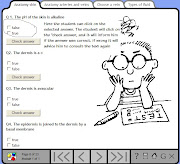http://www.medscape.com/viewarticle/705357?src=mp&spon=24&uac=114262EY
I have found the above article of particular interest for those of us that work and teach in the critical care environment. Although this does not have direct relevance to what this blog is about, it certainly impacts on patient safety on a day to day basis.
I will focus my e-learning event on the clinical skill of commencing an intravenous infusion as well as administering intravenous medication. This skill is required from nurses and medical personnel alike and is taught in the 2nd year of the nursing curriculum, and the 3rd year of the medical curriculum. Maintaining competence is a matter of practice and self-confidence. Clinical follow-up and facilitation post-skills lab training is very important if we would like our students to safely master this skill.
Until later...
Estelle
That's life.....
Faith and hope... I re-discovered these two friends today. Is it not amazing how these two concepts affect the way we view ourselves and the world around us. Faith and hope motivates us to never give up. To try again. Keep them close to your heart as they will guide you through tough times.
Subscribe to:
Post Comments (Atom)

Hi Estelle
ReplyDeleteThe placing and maintenance of an intravenous line is certainly a very necessary skill for nursing and medical staff alike. And a source of frustation to our SI's who are called to wards at 02:00 in the morning to re-commence a line which is only needed for an intravenous dosis the next morning. They often wonder why some sisters are masters of the procedure and others are hesitant to perform it. How accessible are the veins on the model, or will you use "real" persons? Students have to be aware that some people's veins are just more difficult to access than pthers. Do you intend teaching them anything about complications of intravenous lines, or about precautions when giving specific medications? I guess not to junior students, where the main aim is probably learning the skill. Perhaps one should just make them aware that such precautions exist and that they should "individualise" each patient.
Nice evening
Wilhelm